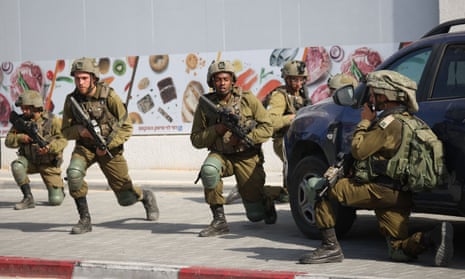There are two key questions in the immediate aftermath of Hamas’s surprise assault on Israel: what was the attack designed to achieve, and why now?
Even as the Israeli prime minister Benjamin Netanyahu announced that Israel was at war with Hamas and the other Gaza factions, it is important to understand what Hamas’s military aims did not include. Hamas fights its periodic conflicts for political reasons, to shore up support in Gaza and elsewhere and to ensure its continuing relevance.
Hamas’s military leadership is aware of its own capabilities. Taking and holding ground in Israel is far beyond its reach. As the kidnapping and killing of Israeli civilians makes clear, this is an operation that was designed both to terrorise and to have as wide an international audience as possible.
And while the proximate causes of Israeli-Palestinian violence are always urgent and important, not least decades of occupation, what appears key to the timing of this assault is the wider context in the region, not least the ongoing US-brokered normalisation between Israel and Saudi Arabia that has been gathering pace recently.
Amid the continuing impotence and irrelevance of the Palestinian Authority under President Mahmoud Abbas in Ramallah, the efforts by Washington first under Donald Trump (with the Abraham Peace Accords) and more recently under Joe Biden to subcontract large parts of the Middle East process to side deals with the Gulf kingdoms were always unpredictable.
While the US and Saudi Arabia have long understood that any progress on normalisation was dependent on movement towards a two-state solution, the two stumbling blocks were always seen as a far-right Israeli government that many saw as unable to compromise and a Hamas movement in Gaza outside the talks and liable to act as a spoiler.
While there have long been those in Israeli politics, Netanyahu prominent among them, who have pushed for a peace process that deals with the Palestinian question as a bolt-on to the wider process in the hope of presenting that peace to the Palestinians as a fait accompli, Hamas has always been clear-eyed about what that approach might mean for it.
What is surprising is that even earlier this year the complicated and often fractious relationship between Saudi Arabia and Hamas appeared to be warming, with a Hamas delegation visiting Riyadh for the first time in seven years. That came against a background of Riyadh’s own pivot towards China and better relations with Syria’s Bashar al-Assad, which was seen as giving Hamas an opening.
Detailed analysis of Hamas’s thinking in launching this attack is likely to be a drawn out process, not least because Israel, understandably the country with the closest insight, was blindsided about those deliberations.
The reality is that while Hamas has dressed up the attack as a response to Israeli incursions around the al-Aqsa mosque in Jerusalem, it chose to trigger this conflict – at this time and in the way it did – as a way to impose itself in that wider diplomacy.
One of the oldest saws of Middle East reporting and analysis is the perceived gulf between elite attitudes in governance circles in Arab states and the views of the wider population in the countries in the region.
It is a divide that Israeli-Palestinian conflicts have exposed in the past and that has forced Arab countries – even those that have made little secret of their frustration with the Palestinian leadership under Abbas – to walk a tightrope of public statements and actions. Indeed, the language of Hamas’s military commander Mohammed Deif in announcing the assault was instructive. “Today the people are regaining their revolution,” Deif said in a recorded message, as he called on Palestinians from East Jerusalem to northern Israel to join the fight, suggesting Hamas views the attack as an attempt to reclaim control over the Palestinian narrative.
And while the appeal over Al-Aqsa is a popular one, underlined by mounting tensions around the site, the gravity of Hamas’s assault seems deliberately designed to prompt a very significant Israeli assault against Gaza, with all the inevitable civilian casualties that would involve. Deif’s wider appeal to the “Islamic resistance in Lebanon, Iraq, Syria and Yemen” was also aimed specifically at countries who have militant movements supported by Iran, not least Hezbollah in Lebanon.
What is clear is that the conflict has beneficiaries outside of Hamas.
